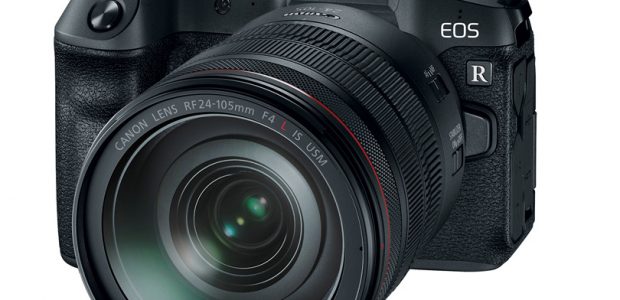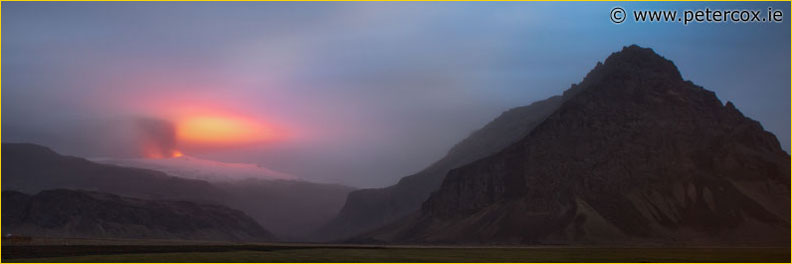
Eyjafjallajökull, Night
Back in late March of 2010, I became aware that there was a spectacular eruption under way in Iceland. I immediately changed my plans from a trip to Scotland at the end of April to one to Iceland, and hoped that there would still be something for me to photograph when I got there.
Of course, very soon after I made my plans, the original eruption stopped. However, the main event was just gathering steam. A few days later, the ice covering the main crater onEyjafjallajökull(rough phonetic: Ay-ya-fyatla-yo-cutl, or seethe Wikipedia entryfor an audio recording) started to collapse in on itself, and the eruption that has caused travel chaos the world over began.
Luckily for me, but perhaps not so much for the rest of the world, the eruption was still going on at the beginning of my trip. In this
article, I’ll pass on some of the things I’ve learned about volcano photography and specific advice that may be of use to you if you plan to go and photograph this particular eruption.
___________________________________________________________________________________
Getting There
It helps to have a certain flexibility in your travel plans, as you’ll be flying to the source of the travel disruption. International
flights arrive at Keflavik, near the capital of Reykjavik. If the ashcloud is over that airport, then flights are diverted to Akureyri – at
best a four hour drive from Reykjavik. During my stay there were a couple of days where both airports were closed, but on the whole at least one was open. In short, don’t travel too close to your wedding, or other important event that you can’t afford to be late for!
Once you’re in Iceland, you’ll need transport. I strongly recommend renting a 4×4, and making sure that you’re covered for river crossings with your insurance. If you prefer not to drive yourself, there are many jeep tour operators who will act as driver and guide for you, but you’ll obviously end up paying more. This is a good option if you’re not comfortable with driving on gravel roads or fording rivers.
If you don’t rent a 4×4, then you won’t be able to get to the best observing site for the volcano, as that does involve a moderate river crossing. So be warned.
Lastly, you’ll need a place to stay. The closest town of any size to the eruption is Hvolsvöllur, which is where I stayed. This is about an hour and a half from Reykjavik and maybe half an hour to close views of the eruption. However, the volcano itself is visible for miles around on a good day. There are many small hotels and guesthouses in the region, any of whom would suffice. Accommodation is often basic, but comfortable.
Lastly, just a word on common sense – the interior of Iceland is a wilderness. Heed road closure signs and read the guide to driving in Iceland from their road safety authority. If you do plan on crossing any rivers, do so with all due caution.
___________________________________________________________________________________
Best Vantage Points
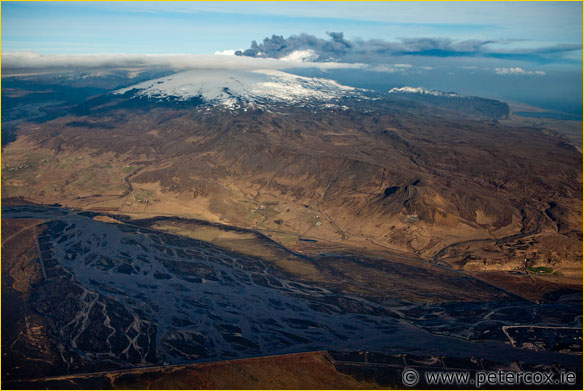
Eyjafjallajökull with the river Markarfljót in foreground.
At the time of this writing (May 5th, 2010), the closest access possible to the volcano is at the base of Þórólfsfelli mountain. North
of the mountain is a valley, through which the river Markarfljót flows. This is the main drainage for both the Eyjafjallajökull and Mýrdalsjökull glaciers. The vantage point is on the road that follows this river’s northern bank, just at the roadblock set up by the
Icelandic police. Getting there involves driving along a gravel road, crossing a small river and then following a rough track to the
roadblock. If in doubt, pay a visit to the police station in Hvolsvöllur and they’ll point out the spot.
There are also good views to be had from the south side, along the ring road. Here you can see the blackened farmland due to ashfall, with the volcano summit in the background. Cleanup efforts are ongoing, but until the volcano stops producing it, there’s always fresh ash to be had. Depending on wind and rain conditions it can be very clear or visibility can drop to zero.
Bringing a few dust masks and a pair of safety goggles (the kind that fit snugly to your face) is advisable, although I never had to use mine. Volcanic ash is very abrasive and will lead to breathing difficulties/coughing and eye irritation if you’re exposed to it for
any length of time and don’t guard against it.
Depending on the conditions when you’re there, it may be possible to hire a glacier guide to take you up on either the Eyjafjallajökull or Mýrdalsjökull glaciers, or to the original eruption site at Fimmvörðuháls. However, as of this writing, these areas are still restricted.
In any event, the best views of the volcano are certainly to be had from the air. You can hire a pilot to fly you around the mountain, and can get very close to the crater (depending on the pilot’s skill and the conditions on the day). This can lead to some excellent
photographic opportunities, although it is of course not cheap.
It’s possible to fly around the volcano because piston engine aircraft aren’t subject to the same problems with ash as airliners. The temperatures in the engine aren’t sufficiently high to melt the ash, which is what clogs up jet engines.
___________________________________________________________________________________
Best Times for Photography
From the ground, definitely the best times for photography are at night. The eruption is not so violent that you can see the lava
clearly during the day – it only becomes visible after dark. During the daytime, you see the ash and steam clouds clearly, but that’s about it. That being said, the lava flow is expected to reach the bottom of the Gígjökill outlet glacier by mid-May, and will be more visible then. Nonetheless, it’ll still be more photogenic at night.
Unfortunately, Iceland’s nights are getting shorter by the day. During my trip, there was only about two hours of good darkness, and even then there was a clear brightness in the eastern sky. On both the good evenings I had, I spent the whole night at the Þórólfsfelli location, at least until dawn at 5am, but the best photography was between midnight and 2am.
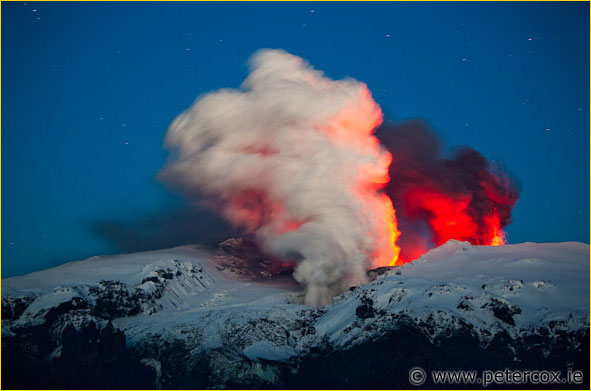
Steam and Ash, Eyjafjallajökull Volcano, Iceland
As the year goes on, the nights get brighter. At the summer solstice in June, even at 2am you can read a newspaper on a good night. This means the ash plume will be less illuminated by the lava (as in the image above), but it should still be possible to get some great photography – especially since at that point the lava will be at the bottom of the mountain (all assuming that the eruption keeps going that long, which is a distinct probability).
___________________________________________________________________________________
A Note on Clothing
Iceland would never be described as a warm country. In the dead of night, standing around your tripod, you’ll get very cold if you’re not dressed for it. Many layers with plenty of fleece, hat(s), good boots and warm socks are vital. A windbreaker and over-trousers are a must. A thermos of hot coffee wouldn’t go amiss either.
___________________________________________________________________________________
Weather
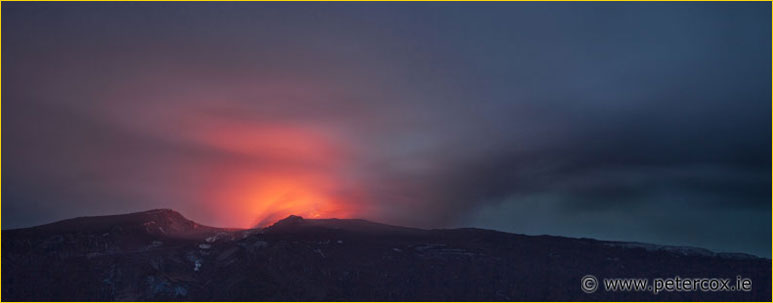
Eyjafjallajökull from Þórólfsfell, Nocturne
Hopefully on your trip you’ll have great weather. More likely though, you’ll have at least a few bad days with wind and rain. It’s still
possible to get good images. The image above was made on a night with raging winds and scattered rain. Only myself and two other people were braving the conditions on that night, sheltered behind a rock wall.
When dealing with conditions like these it’s vital to have a rain cover for your camera and to have a good, solid tripod. I hung my
heavy camera bag from the hook on my tripod and secured it to the legs to prevent it swinging in the wind. Spikes on the feet allowed me to drive it into the ground, further solidifying it.
Luckily this was the only evening I had such bad conditions, but my understanding is that sort of wind is pretty common in that valley.
___________________________________________________________________________________
Ash
I didn’t have to deal with any significant ashfall on my trip, but blowing ash can be a problem. Take care when changing lenses and if there’s a lot of it about, use your rain cover with the zips cinched tight to protect the camera. I think it’ll be pretty much a given that you’ll have grinding sounds from your focusing and zoom rings if you’re out in falling or blowing ash – but that’s the price you pay to get those photographs.
___________________________________________________________________________________
Lenses
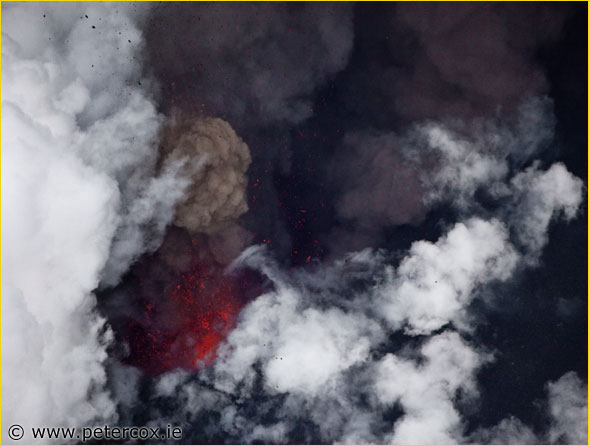
Eyjafjallajökull Eruption, Detail
This is an event that can be photographed equally interestingly all the way from wide-angle to super telephoto. On my trip, I had lenses from 12mm to 280mm. Mostly I found myself using the 24-200mm range, but had cause to break out the super-wide and tele-extender too. The image above is from an overflight of the volcano, right over the crater. It was taken at 200mm, the idea being to isolate the chaos of the eruption itself.
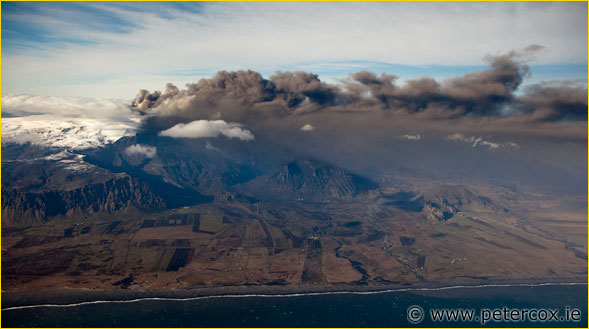
Eyjafjallajökull Eruption, Context
This image was also made from a plane on a seperate flight. Here we flew a couple of miles out to sea and photographed the volcano at 24mm to see the context – here you can see the ash-covered landscape in front of the volcano, as well as the culprit itself.
From the ground, there are many ways to compose your images. Using a wide angle lens you can use the river as a foreground – there are plenty of interesting shapes in the gravel banks. If there are chunks of ice accessible that were washed from the glacier by the floods, you can use those to great effect.
Alternatively you can use your telephoto lens to photograph the detail of the eruption itself at the summit. When using a telephoto at night, take great care to focus it accurately. Autofocus will most likely not work, and manually focusing can be a problem. I used live view and manually focused on lights in the distance until they were pin sharp, then directed the camera at the volcano. Make sure you check your images for sharpness by zooming in on the LCD preview – something I overlooked on a few images which I found to be unsharp when I arrived home. That’s not a position you want to find yourself in.
Having a good lens hood and using it on calm nights is also vital. On a good night, the Þórólfsfelli site can be a busy place. Jeeps with bright headlights will come by at regular intervals. The headlights can ruin an otherwise great image with flare, so using your hood to protect the lens, and interposing yourself between the lights and the camera is a good idea.
___________________________________________________________________________________
Alternative Ideas
If you have patience, and/or a second camera and tripod, you can get some great time lapse sequences of the volcano, day or night. This will convey the motion of the ash cloud which is obvious when standing there, but moves a bit too slowly to really make an impact in a short video sequence. A time lapse will compress several minutes or hours into a few seconds and really show that movement.
I ran into some equipment problems while I was there that limited my ability to shoot time lapses, but I still got these few seconds, which I’m quite happy with:
Eyjafjallajökull, Iceland, April 2010fromPeter CoxonVimeo.
___________________________________________________________________________________
In Conclusion
Volcanos can make for some pretty spectacular landscape photography. Eyjafjallajökull is now becoming what the Icelanders call a ‘tourist eruption’ – i.e., a relatively safe and stable volcano that can be photographed from reasonably close range.
If you’re willing to put up with some of the difficulties, it can make for once-in-a-lifetime photographic opportunities – with the right
attitude and equipment.
May, 2010
___________________________________________________________________________________
Peter Cox
Peter Cox is a landscape photographer and educator living in the beautiful south-west of Ireland. He offers a variety ofphotography workshops, fromten-day touring workshops of Irelandtoriver rafting photo trips down the Zambezi. For more of his work, you can visit his gallery at:http://www.petercox.ie
Peter Cox, AIPPA
Irish Landscape Photographer of the Year, 2007
Digital Photography Workshops – Fine Art Prints – Landscape &
Architectural Photography
You May Also Enjoy...
Canon EOS R Camera Launched
FacebookTweet Breaking News Dateline Tuesday, September 4th, 2018, 9:00 HWT Canon Camera has released their long-awaited mirrorless camera. The EOS R is a camera
